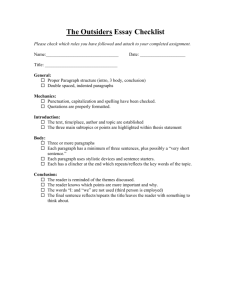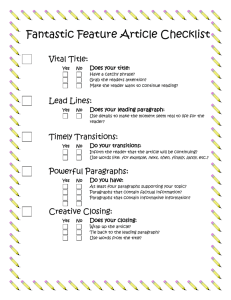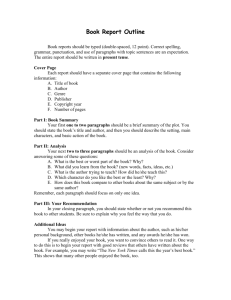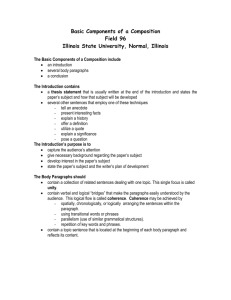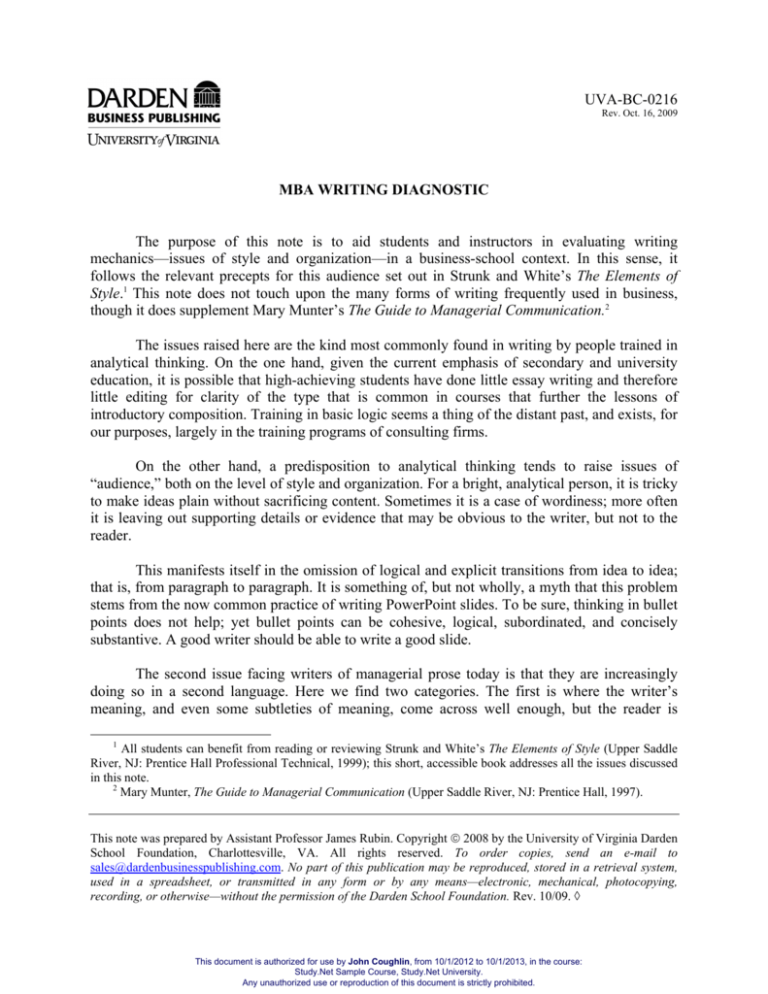
UVA-BC-0216
Rev. Oct. 16, 2009
MBA WRITING DIAGNOSTIC
The purpose of this note is to aid students and instructors in evaluating writing
mechanics—issues of style and organization—in a business-school context. In this sense, it
follows the relevant precepts for this audience set out in Strunk and White’s The Elements of
Style.1 This note does not touch upon the many forms of writing frequently used in business,
though it does supplement Mary Munter’s The Guide to Managerial Communication.2
The issues raised here are the kind most commonly found in writing by people trained in
analytical thinking. On the one hand, given the current emphasis of secondary and university
education, it is possible that high-achieving students have done little essay writing and therefore
little editing for clarity of the type that is common in courses that further the lessons of
introductory composition. Training in basic logic seems a thing of the distant past, and exists, for
our purposes, largely in the training programs of consulting firms.
On the other hand, a predisposition to analytical thinking tends to raise issues of
“audience,” both on the level of style and organization. For a bright, analytical person, it is tricky
to make ideas plain without sacrificing content. Sometimes it is a case of wordiness; more often
it is leaving out supporting details or evidence that may be obvious to the writer, but not to the
reader.
This manifests itself in the omission of logical and explicit transitions from idea to idea;
that is, from paragraph to paragraph. It is something of, but not wholly, a myth that this problem
stems from the now common practice of writing PowerPoint slides. To be sure, thinking in bullet
points does not help; yet bullet points can be cohesive, logical, subordinated, and concisely
substantive. A good writer should be able to write a good slide.
The second issue facing writers of managerial prose today is that they are increasingly
doing so in a second language. Here we find two categories. The first is where the writer’s
meaning, and even some subtleties of meaning, come across well enough, but the reader is
1
All students can benefit from reading or reviewing Strunk and White’s The Elements of Style (Upper Saddle
River, NJ: Prentice Hall Professional Technical, 1999); this short, accessible book addresses all the issues discussed
in this note.
2
Mary Munter, The Guide to Managerial Communication (Upper Saddle River, NJ: Prentice Hall, 1997).
This note was prepared by Assistant Professor James Rubin. Copyright © 2008 by the University of Virginia Darden
School Foundation, Charlottesville, VA. All rights reserved. To order copies, send an e-mail to
sales@dardenbusinesspublishing.com. No part of this publication may be reproduced, stored in a retrieval system,
used in a spreadsheet, or transmitted in any form or by any means—electronic, mechanical, photocopying,
recording, or otherwise—without the permission of the Darden School Foundation. Rev. 10/09. ◊
This document is authorized for use by John Coughlin, from 10/1/2012 to 10/1/2013, in the course:
Study.Net Sample Course, Study.Net University.
Any unauthorized use or reproduction of this document is strictly prohibited.
-2-
UVA-BC-0216
distracted by, for example, the incorrect use of the definite and indefinite article—the problem
plaguing writers whose first language is an Asian language or Spanish or Finnish, in which the
definite article “en” is attached to the end of a noun. In this case, writers must decide if they are
willing to put in the time to learn to write English prose as if they were writing English as a first
language.
More serious problems arise when a writer’s meaning does not come across because of
issues of diction, agreement, and other basic grammatical errors. This cannot be fully addressed
here, and the writer must seek additional aid; again, Strunk and White is an excellent reference.
Micro Writing
At its most worrisome, issues of style have not so much to do with the way you express
yourself in writing, but with fundamental difficulties in expressing your ideas. This can stem
from a number of problems: word choice or diction; convoluted or incorrect syntax; run-on
sentences; agreement of number or tense; excessive wordiness; grammatical mistakes such as use
of the possessive, pronouns, and the definite and indefinite article; and repetition. As a result, the
reader gets lost within your sentence.
Readers also get lost when they are improperly targeted. Whether the prose itself is
“correct,” the failure to identify and speak to your particular audience can mean a failure to make
your point. This problem is widespread among bright, analytical people—just because you
understand something, you assume your reader will. Don’t.
At the next level, you are able to express your ideas, but they could be expressed more
accurately, clearly, concisely, and lucidly. At this level, many of the issues just listed come into
play, albeit less severely. Other issues that might inhibit your effectiveness are the overuse of
declarative sentences rather than cause-and-effect structures or sentence variety; overly long
sentences using too many prepositional phrases; and inflated diction. Here, the main culprit may
be writing in the passive voice, employing jargon, or overusing the many forms of the verb “to
be” (related to declarative sentences). The quickest way to check this is through editing: Circle
all forms of the verb “to be” and all propositional phrases (beginning with to, for, of, and so on),
then see what you can eliminate or tighten. Writing is editing.
Finally, “style” means what it may originally have suggested to you: the style in which
you write. Is your prose jargon-ridden, journalistic, too formal, or too informal in tone? Writing
can convey a denser level of information than oral communication. Still, a good rule of thumb
for American managerial writing is to avoid writing in sentences you would never say in any
setting, formal or informal. As you seek your managerial voice, strive to write in a way that
expresses your own voice, that “sounds” as if it is written by you, not made up of clichés and
buzzwords.
This document is authorized for use by John Coughlin, from 10/1/2012 to 10/1/2013, in the course:
Study.Net Sample Course, Study.Net University.
Any unauthorized use or reproduction of this document is strictly prohibited.
-3-
UVA-BC-0216
Macro Writing
The unit of organization in composition is the paragraph. Thus the first question in
organization is whether or not paragraphs “hold together.” A paragraph is the exposition of one
idea. At the graduate-school level, you will be dealing with a set of concepts that most likely will
require paragraphs of some substance. Paragraph unity does not mean sets of one- or twosentence paragraphs, even in business-oriented writing. This is simply choppy paragraphing.
Some people write with an outline; some people write to see what they think. In either
case, editing is essential. Does your paragraph have a topic sentence? Is the paragraph an
exposition of the idea stated in that sentence? Are paragraphs mostly of the same size
accommodated to the length of what you are writing? Are you writing “to scale”?
Organization can also mean the order of your paragraphs. Do the paragraphs develop
your main idea sequentially, or do they seem out of order? Could they be more effectively
placed? In drafting, you may not arrive at your central idea until the final paragraph, but this
means that in editing you should probably make that your first paragraph and adjust accordingly.
Good business writers use format, but they do not use it to let them off the hook by skipping
logical development and effective organization.
Focus
Assuming style and organization are under control, the hurdle for many graduate-school
writers is moving from one idea to the next, further developing an idea, thesis, or, in business,
most likely a recommendation. Are sentences and paragraphs working together to develop your
central hypothesis? Are you technically in control but making too many unsupported assertions
(plainly related to style)?
The trick to focused writing is making adequate transitions from one topic sentence to
another, clearly relating all your points for the reader to your main idea; or put another way,
taking the reader plainly from idea to idea. Contrary to clichés suggesting you should end up
where you start, at the graduate level, you should take your reader to a new and more
sophisticated level of understanding of the topic under discussion. This can only be done if you
are writing to scale. Is your focus split because you are taking on too much for the length of the
assignment? Do you have the grit to eliminate what is unnecessary or to resist sticking in one
extra idea that is at a tangent to your purpose? Again, the words most often used to praise
managerial writing are “concise” and “brief,” but this does not mean you write so sparely that
you do not get the job done—you must, for example, build verbal bridges between ideas within
and between paragraphs. Brevity and concision are often a matter of using active voice and
active verbs, not merely writing less. Focused writing is thesis-driven writing. You may not
always use it, but you need to know how to do it.
This document is authorized for use by John Coughlin, from 10/1/2012 to 10/1/2013, in the course:
Study.Net Sample Course, Study.Net University.
Any unauthorized use or reproduction of this document is strictly prohibited.
-4-
UVA-BC-0216
Expressing Your Ideas
Problems of style and organization will significantly inhibit your success as a student, in
writing exams, essays, cover letters, and résumés. Writing expresses thinking, and, even though
writing is a technical challenge, you will be evaluated on how well you can express your ideas
and present yourself. If you wish to perfect your writing, ask your instructor for suggestions or
referrals to others who teach the narrative model, and perhaps make arrangements to visit your
university’s writing center.
This document is authorized for use by John Coughlin, from 10/1/2012 to 10/1/2013, in the course:
Study.Net Sample Course, Study.Net University.
Any unauthorized use or reproduction of this document is strictly prohibited.


